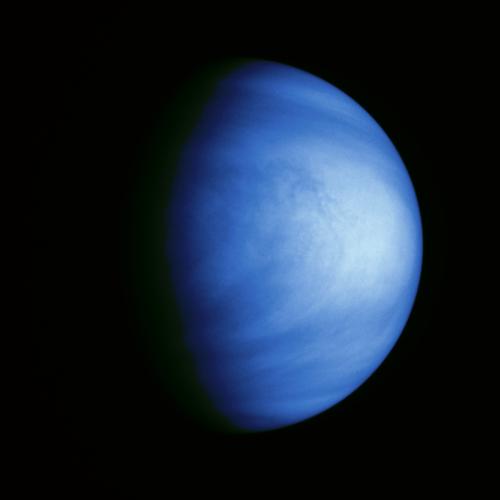
Original 192kB tif
This picture of Venus was taken by the Galileo spacecrafts Solid State Imaging System on February 14, 1990,
at a range of almost 1.7 million miles from the planet.
A high pass spatial filter has been applied in order to emphasize the smaller scale cloud features, and the
rendition has been colorized to a bluish hue in order to emphasize the subtle contrasts in the cloud markings
and to indicate that it was taken through a violet filter.
The sulfuric acid clouds indicate considerable convective activity, in the equatorial regions of the planet
to the left and downwind of the subsolar point (afternoon on Venus).
They are analogous to 'fair weather clouds' on Earth.
The filamentary dark features visible in the colorized image are here revealed to be composed of several dark
nodules, like beads on a string, each about 60 miles across.
The Galileo Project is managed for NASA's Office of Space Science and Applications by the Jet Propulsion
Laboratory; its mission is to study Jupiter and its satellites and magnetosphere after multiple gravity assist
flybys at Venus and Earth.
These images of the Venus clouds were taken by Galileo's Solid State Imaging System February 13,1990, at
a range of about1 million miles. The smallest detail visible is about 20 miles.
The two right images show Venus in violet light, the top one at a time six hours later than the bottom one.
They show the state of the clouds near the top of Venus's cloud deck.
A right to left motion of the cloud features is evident and is consistent with westward winds of about 230 mph.
The two left images show Venus in near infrared light, at the same times as the two right images.
Sunlight penetrates through the clouds more deeply at the near infrared wavelengths, allowing a view near the
bottom of the cloud deck. The westward motion of the clouds is slower (about 150 mph) at the lower altitude.
The clouds are composed of sulfuric acid droplets and occupy a range of altitudes from 30 to 45 miles.
The images have been spatially filtered to bring out small scale details and de-emphasize global shading.
The filtering has introduced artifacts (wiggly lines running north/south) that are faintly visible in the
infrared image.
The Galileo Project is managed for NASA's Office of Space Science and Applications by the Jet Propulsion
Laboratory; its mission is to study Jupiter and its satellites and magnetosphere after multiple gravity assist
flybys at Venus and Earth.

Original 80kB tif
Original Caption Released with Image:
This colorized picture of Venus was taken February 14, 1990, from a distance of almost
1.7 million miles, about 6 days after Galileo's closest approach to the planet.
It has been colorized to a bluish hue to emphasize subtle contrasts in the cloud markings
and to indicate that it was taken through a violet filter. Features in the sulfuric acid
clouds near the top of the planet's atmosphere are most prominent in violet and ultraviolet
light. This image shows the east-to-west-trending cloud banding and the brighter polar
hoods familiar from past studies of Venus.
The features are embedded in winds that flow from east to west at about 230 mph.
The smallest features visible are about 45 miles across. An intriguing filamentary dark
pattern is seen immediately left of the bright region at the subsolar point (equatorial 'noon').
North is at the top and the evening terminator is to the left.
The Galileo Project is managed for NASA's Office of Space Science and Applications by the
Jet Propulsion Laboratory; its mission is to study Jupiter and its satellites and magnetosphere
after multiple gravity-assist flybys at Venus and Earth.
[NASA/JPL/Space Science Institute]
|

ALPO-Japan Latest

Venus Section
